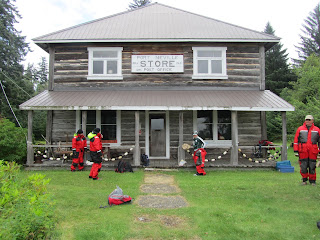The latest fashion in whale watching attire! Very elegant! We all had to wear a survival suit - kind of like an all body life jacket. In the end I was glad to be wearing it as not only did we get sprayed with sea water numerous times, but it was very cold!!
Our route took us via the famous Inside Passage where all the cruise ships take their passengers up to Alaska. We saw lots of rugged heavily forested mountains and rocky shorelines.
It was hard to keep the camera level as the water was very choppy at times and the front of the zodiac was bouncing up over the waves and slamming down back in to the water. Joel and I sat in the front row. "Try and sit in the front row to get the best views," advised Leigh. The front row also gets the wettest and roughest ride. Thankfully, the ginger tablets Jay gave me worked and I did not get sea sick and actually enjoyed the rough ride!
Shortly after WWII the numbers of salmon began to rapidly decline. The suspected cause was large numbers of orcas (killer whales). It was thought that there were thousands of them migrating annually through this narrow channel. A group of local men got a WWII machine gun set up on this headland, aiming to reduce the orca numbers. They practiced shooting it, aiming at birds. Finally, they were ready - and that year the orcas never came! (Somehow they knew not to come that year!?)
Then more scientific research was done and it was discovered that there were only several hundred orcas, not thousands, so obviously there was another cause for the salmon decline. And, thankfully, the gun was removed.
They also use tug boats to tow large barges all the way to Alaska, loaded with freight and supplies.
Lunch time - at Port Neville, on a remote part of the mainland, only accessible by boat. This used to be the post office and store.
Our orange zodiac boat tied up to the wharf for lunch.Before lunch we did spot some bald eagles, seals, and a bear on the shoreline.
After lunch we finally started seeing whales and porpoises. (Sorry - not very good photos)
A pod of Dall's porpoise feeding and diving under and around our boat. They are sometimes confused with baby orcas due to their black and white colouring.
One humpback whale feeding probably on small herring.
Down he goes for a deep dive of 6 to 8 minutes.
Finally - orcas!! I have seen humpbacks before as they migrate past Devonport every year, but never orcas, so I really wanted to see them.
At first, just a solitary male feeding. Then a group of about 6 swimming along in perfect unison. Then the male again. Our tour leader was constantly communicating with whale researchers in the area, and knew which orcas we were seeing. We were not allowed to get closer than 100 metres. The orca has quite a different dorsal fin to the hump back. It is long and upright. And when it goes down for a deep dive it does not put its tail up high in the air like the humpback does.
Nine hours and 208 nautical miles - epic!!! Exhausting but worth every mile and wave!















No comments:
Post a Comment